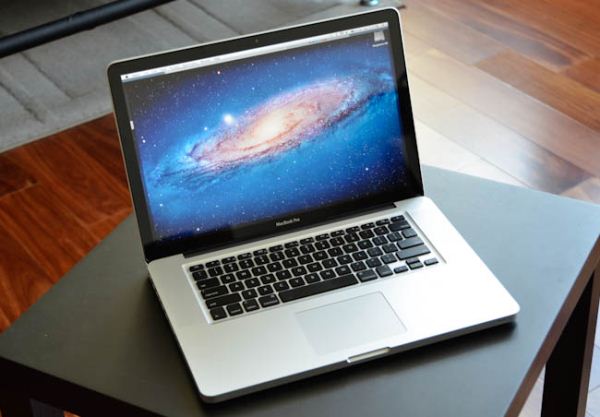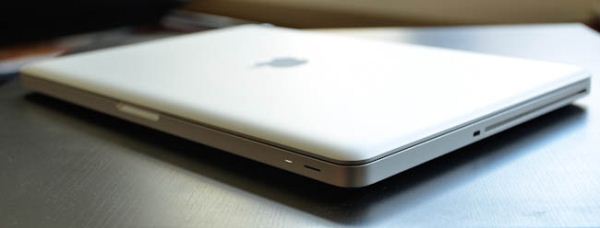The 2012 MacBook Pro Review
by Vivek Gowri on July 18, 2012 2:00 PM EST- Posted in
- Mac
- Apple
- MacBook Pro
- Laptops
- Notebooks
With most of the attention from Apple's hardware refresh event centered around iOS 6 and the new Retina MacBook Pro, the updated 2012 edition of the regular MacBook Pro has flown a little bit under the radar. Basically, it’s just an Ivy Bridge-infused version of the venerable unibody MacBook Pro chassis that we’ve known and loved for the last few years. The details don’t bring any particularly earth-shattering revelations, with 13” retaining the dual-core processor and integrated graphics, while the 15” makes the switch from AMD to Nvidia’s new Kepler-based GT 650M dedicated graphics. Along with Ivy Bridge, the 2012 MBP line gets HD 4000 graphics and USB 3.0 across the board, plus a free update to Mountain Lion when it releases later this summer. Naturally, it doesn’t generate the same kind of excitement that the all-new, all-awesome Retina MacBook Pro does. But is a less headline-worthy computer necessarily a worse one?
It’s pretty difficult to find things to write about the 2012 MacBook Pro hardware. You can essentially sum it up in one paragraph, or even one sentence if you try hard enough. The 2012 MBP looks exactly like the 2011 MBP, which looked exactly like the 2010 MBP, which looked exactly like the post-April 2009 MBP. It’s likely to be the last iteration of the original unibody MBP, giving this body style a 4.5 year run as one of the most instantly recognizable notebook computers on the market. I’m not going to go too far in depth with analyzing the design, because we’ve gone over it a few times over the years (here, here, here, here, here, and here. Oh and here too, just for good measure.)
It’s a solid notebook, that much is certain. From an SKU standpoint, Apple has kept things relatively straightforward, with a high end and a low end for both the 13” and 15” models. Starting at $1199, the MBP13 comes with a 2.5GHz Core i5-3210M, 4GB DDR3, and a 500GB HDD, while the higher end SKU bumps that to a 2.9GHz i5-3520M, 8GB DDR3, a 750GB HDD, and a $1499 pricetag. Other than the updated processor/integrated graphics and the addition of USB 3.0, the 13” is identical to the previous model that we covered in depth last year.
The 15” is a bit more interesting. The base $1799 SKU comes with a quad-core i7-3615QM (2.3GHz) and a 512MB Nvidia GeForce GT 650M dGPU, but makes do with a paltry 4GB of memory and a 500GB hard drive. The standard memory and storage configuration in a nearly-$2000 notebook is pretty unacceptable. This being Apple, upgrade pricing is still a hair away from being highway robbery, but at least the matte WSXGA+ screen upgrade costs a reasonable $100. Thankfully, unlike the rMBP and MacBook Air, you can always opt to buy RAM and storage upgrades on your own.
| 2012 MacBook Pro Lineup Comparison | |||||
| 15-inch Mid 2012 MacBook Pro | MacBook Pro with Retina Display | ||||
| Dimensions | 0.95 H x 14.35 W x 9.82" D | 0.71 H x 14.13 W x 9.73" D | |||
| Weight | 5.6 lbs (2.54 kg) | 4.46 lbs (2.02 kg) | |||
| CPU | Core i7-3615QM | Core i7-3720QM | Core i7-3615QM | ||
| L3 Cache | 6MB | 6MB | 6MB | ||
| Base CPU Clock | 2.3GHz | 2.6GHz | 2.3GHz | ||
| Max CPU Turbo | 3.3GHz | 3.6GHz | 3.3GHz | ||
| GPU | Intel HD 4000 + NVIDIA GeForce GT 650M | ||||
| GPU Memory | 512MB GDDR5 | 1GB GDDR5 | |||
| System Memory | 4GB DDR3-1600 | 8GB DDR3-1600 | 8GB DDR3L-1600 | ||
| Primary Storage | 500GB 5400RPM HDD | 750GB 5400RPM HDD | 256GB SSD | ||
| Optical Drive | Y | Y | N | ||
| Display Size | 15.4-inches | ||||
| Display Resolution | 1440 x 900 | 2880 x 1800 | |||
| Thunderbolt Ports | 1 | 2 | |||
| USB Ports | 2 x USB 3.0 | ||||
| Other Ports | 1 x Firewire 800, 1 x Audio Line in, 1 x Audio Line out, SDXC reader, Kensington Lock slot | SDXC reader, HDMI out, headphone out | |||
| Battery Capacity | 77.5 Wh | 95 Wh | |||
| Price | $1799 | $2199 | $2199 | ||
The unit we’re looking at here is the high-end 15” SKU, with a 2.6GHz i7-3720QM and a 1GB version of the GT 650M, plus 8GB memory and a 750GB HDD. It rings up at $2199, which interestingly is the same as the base rMBP (i7-3615QM/8GB/256GB SSD/1GB GT 650M). I’m mostly certain that it’s not the configuration to get - you’re better served by getting a base 2.3GHz 15”, adding the $100 high-res screen, and grabbing a 256GB SSD (~$250) and an 8GB RAM upgrade (~$50) separately from Newegg or Amazon. Boom. You spend roughly the same $400, depending on your SSD choice (I would go Samsung SSD 830), and end up with a system with a better screen that’s faster in most day to day situations. Unless you have a really specific need for the extra 512MB vRAM or 300MHz clock speed increase, I’d recommend against it.












132 Comments
View All Comments
dwade123 - Thursday, July 19, 2012 - link
Apple needs to redesign the 13" Pro. Get rid of optical drive, put in Quadcore, Retina, and at least a GT 640m.Airkol - Thursday, July 19, 2012 - link
I've got the Retina but but I want to make this thing rock. I need a fast 512GB drive. This samsung drive is a slug.
I see OWC just announced their upgrade for the MBA 2012. Any word on them having an upgrade fro the Retina?
EnerJi - Thursday, July 19, 2012 - link
I was under the impression that Apple was now shipping pretty fast SSDs? So fast that most users (in most use cases) wouldn't be able to tell the difference between their SSD and a top-of-the-line model.Airkol - Friday, July 20, 2012 - link
One of the drives used in the MBA is a Toshiba that uses the SandForce controller. That is pretty fast. The Retina uses Samsung based drives and they aren't as fast.I went with the base model Retina and the 256GB drive. I'm betting that OWC will have a 480GB drive and an external case for the drive I pull out for less than the difference between the next model up with a 512Gb drive.
Death666Angel - Friday, July 20, 2012 - link
http://www.anandtech.com/show/6005/apples-new-ssd-...Depending on what you do with it, it's pretty fast. :D
Paapaa125 - Saturday, July 21, 2012 - link
Actually Samsung is the faster of the two AFAIK. It is essentially Samsung 830 SSD drive which is one of the fastest SSDs out there and very reliable. Still the best choice for almost all desktop users. You should feel lucky you got Samsung instead of Toshiba.dsumanik - Thursday, July 19, 2012 - link
C'mon Vivek, ethernet no longer relevant?I concede that using a thunderbolt port for an adapter is an appropriate substitute, i mean what does it matter if you are plugging in a cable with a dongle on the end, vs a plain old rj45 connector.
But until wireless networking catches up with ethernet in the latency and STABILITY department, it will always be necessary.
Wireless technology developments seems to keep pushing bandwidth...i want consistent 1ms ping throughput and a 500 meter range without bandwidth/connection loss.
actually screw that, i want one nanosecond throughput...latency is the biggest holdup for all of us now, just like going from a mechanical HDD to a SSD drive, the difference on a wired vs wireless network is immediately noticeable....especially through apps like VNC or remote desktop.
Imagine if the entire north american internet infrastructure went wireless...lol. It would take 5 seconds just to ping this page and 30 seconds to load....after the third try.
Eventually, wireless has the potential and will likely replace wired networks...but today is not that day, id say at least 10 years.
EnerJi - Thursday, July 19, 2012 - link
Everyone's needs are different. Is a wired connection objectively "better?" Yes. Is wireless considered "good enough" for the vast majority of people? Absolutely yes.I've used Ethernet *maybe* three or four times in the past three years for troubleshooting purposes. Will I miss it if I were to get an rMBP? Hard to say for sure, but I'm leaning towards probably not.
The0ne - Thursday, July 19, 2012 - link
I haven't even touch my ethernet port at all. I've traveled quite often overseas as well and still don't even have a need. That is because wi-fi is so abundant and easy to set up that ethernet is just not useful as it once was. Sure it can have it uses when troubleshooting, the only thing I can see myself using it for, but other than that wi-fi serves the 99% fine.zephxiii - Friday, July 20, 2012 - link
I definitely need this for large transfers to and from the server. Sure u can use an adapter...but i hate having to fumble with and carry around adapters.An optical drive is nice for when u *need* to burn something, or access a disc. Granted i rarely use mine but i like being able to burn something when needed without being inconvenienced.
Seems like this *tool* has become less of a tool :(